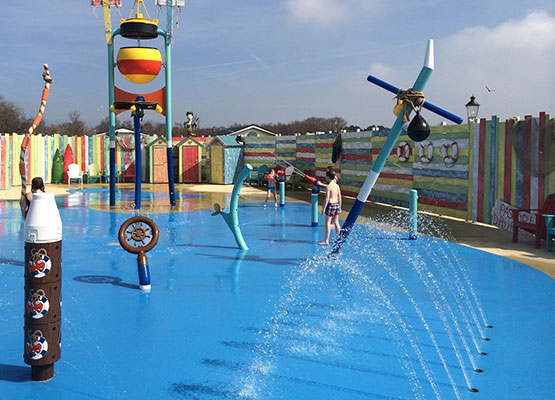Of interest to: Swimming pools, architects & consultants. Reading time: 3 minutes.
The most important prerequisite for the sustainable maintenance of a swimming pool is, of course, the protection of materials from the effects of moisture. This issue has to be addressed as early as the design process for a swimming pool and its features (such as water play equipment). Read more about ‘A watertight design’ here. We at Watergames & More regularly witness that the ultimate choice of water play equipment is based on preferences such as taste and budget, in combination with existing knowledge of traditional materials, while the range of options available is really far broader nowadays. A great deal more can actually be achieved in terms of aesthetics, comfortable & safe use and budget, by simply making the right choice of materials during the design phase. The choice of materials also determines the quality (and therefore the durability) of swimming pool components. That is why our working method invariably devotes particular attention to such choices.
Material properties
The properties of materials may vary greatly. For example, concrete does not adhere well to PVC. Because we use both materials when connecting pipes to our water play equipment, we use epoxy to make a waterproof joint wherever the two converge.
We are also happy to advise clients on the choice of tiling. While it perhaps goes against the grain to choose (too coarse) a non-slip floor finish, a floor that is permanently covered with water is by definition slippier. The appropriate coarseness of the floor finish is therefore vital to the ultimate pleasure of use.
In addition, the risk of rust naturally plays a major role in the choice of materials for water attractions. Wherever steel comes into contact with the combination of air and water (possibly supplemented with swimming pool chemicals) then rusting can occur. If this affects the loadbearing components of water play equipment, it can pose safety risks to bathers. It is therefore important to choose the right material, in the right thickness, while also settling on the right application and installation method for each part of a water attraction, in order to prevent the formation of rust. In the case of mounting components which are subject to stress corrosion, i.e., loadbearing parts of a structure that also come into contact with oxygen, water and swimming pool chemicals, hot-dip galvanised steel is a good choice. The bolts on our slides, for example, are made of this material. It has a thicker zinc layer than electrolytically galvanised steel, and is therefore better protected from the effects of chemicals, which implies that no (stress) corrosion will occur. This makes for both superior product quality and a safe and healthy swimming environment.
In the case of other components of the water play equipment, materials such as stainless steel offer distinct advantages. The experience we have gained in executing highly varied projects sets us in good stead to offer sound good advice on the right choice of materials for each part of the water play equipment.
Facts and fables regarding stainless steel in swimming pools
We regularly witness the reluctance of swimming pools, architects and consultants to use stainless steel in a swimming pool, because of the dubious reputation that such applications have gained in recent years. This also explains the preference for fibreglass reinforced polyester in the manufacture of water play equipment. Given that swimming pool steps and handrails are still made of stainless steel, however, its use is certainly not unadvisable. It is nevertheless crucial that this material is used properly, and that the appropriate qualitative thickness is chosen. After all, provided the application is right, there is no objection whatsoever to the use of stainless steel in playground furniture such as Spray Park equipment (interactive water fountains). And the same applies to an anti-leak flange, for example. In fact, given that this material is ideal for the manufacture of a close-fitting anti-leak flange, while it also adheres well to the waterproofing layer under the floor finish, it is actually more effective to use a stainless steel than another material.
Provided one has sound knowledge and the material is applied appropriately, stainless steel actually offers many advantages in comparison to materials such as polyester. First of all, it is more durable; in terms of functionality, it lasts 25 years, as opposed to polyester’s 10 to 15 years. This is due to the coating on the stainless steel, which shows no sign of wear, in contrast to the top coating on polyester. Stainless steel also remains colourfast for longer and offers opportunities for a more elegant and sleek design and finish, because the material is thinner than polyester. The result is a more aesthetically pleasing and safer product, offering high quality at an affordable price. We therefore consciously opted to create a basic range of Spray Park equipment made of stainless steel and bearing the Waterplay brand.
As a water games specialist, we have extensive technical knowledge of materials and the ability to work with them, enabling us safely use stainless steel in indoor and outdoor swimming pools.

Tailor-made advice
Knowledge of the dos and don’ts of material application in swimming pool water is fundamental to the design possibilities. Based on our knowledge and experience with materials and working methods, we are pleased to advise clients on the possibilities of using materials and the choice of high-quality, sustainable products. After all, this ultimately determines the appearance, the pleasure of use and the ease of maintenance of the water play equipment. Please contact us for further information and tailor-made advice.
Want to stay informed about our developments? If so, then follow us on LinkedIn and Twitter, or subscribe to our newsletter.


Downloads